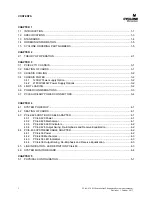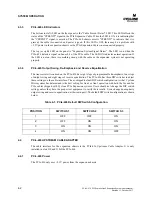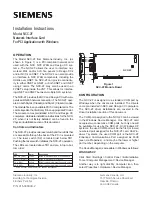
PCIe2-2711 PCI Express Gen2 Expansion System User’s Manual
1-1
Revision 1.1, October 2017
CHAPTER 1
INTRODUCTION
1.1
INTRODUCTION
The Cyclone Microsystems PCIe2-2711 is a PCI Express (PCIe) Gen2 expansion system that allows the
user to add up to eight double width PCI Express add-in-cards. Most PCs contain few PCI Express slots
making them poorly suited for embedded systems requiring many different I/O boards and co-processor
resources. The PCIe2-2711 Expansion System has been designed for applications using multiple GPUs
and other high-powered PCIe devices.
The PCIe2-2711 PCI Express Expansion System permits system developers to use powerful and cost-
effective PCs as a foundation for a robust embedded system. The eight PCI Express slots are organized
as two expansion segment sides, each with four x16 slots and a x16 cable to the host. All expansion
slots accommodate double width, full length and full height cards and are cooled by four 77 CFM fans.
The PCIe2-2711 is available with either a 3240 W or 2180 W N+1 redundant power supply in a 5U
chassis, or a 1200 W standard ATX supply in a 4U chassis.
The Expansion System supports 160 Gb/s bi-directional traffic to and from the host system. The system
utilizes repeaters and non-blocking PCI Express switches for excellent peer-to-peer I/O bandwidth. For
PCs with modern BIOSs, the PCIe2-2711 Expansion System is recognized by the host system upon
boot-up, requires no hardware specific drivers and is entirely host operating system agnostic.
The PCIe2-2711 system is composed of three elements: PCI Express Host Bus Cable Adapters,
Expansion System Cables and an Expansion Chassis. The PCIe-426 Host Bus Cable Adapter card is to
be inserted into a host computer’s x16 PCIe Gen2 slot. The x16 PCIe expansion cable links the PCI
host with the expansion chassis. The expansion chassis is populated with the PCIe-460 Switched
Backplane, two PCIe-436 Upstream Cable Adaptors and, optionally, a System Monitor board.
PCI Express is a high performance, general purpose I/O inter-connect defined for a wide variety of
computing and communication platforms. Key PCI attributes, such as its usage model, load-store archi-
tecture, and software interfaces are maintained, whereas its parallel bus implementation is replaced by a
serial interface. PCI Express take advantage of recent advances in point-to-point inter-connects, switch-
based technology, and packetized protocol to deliver new levels of performance.





































